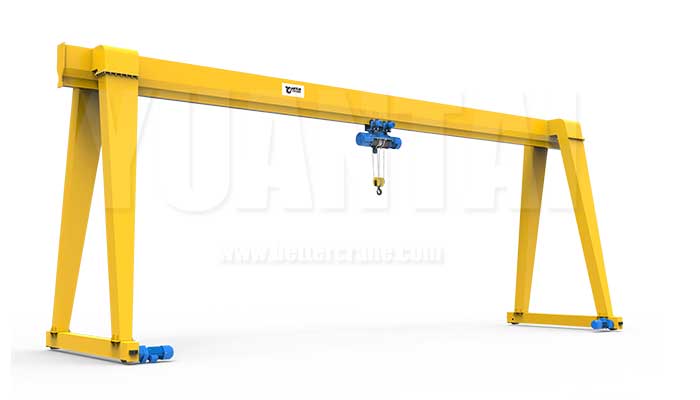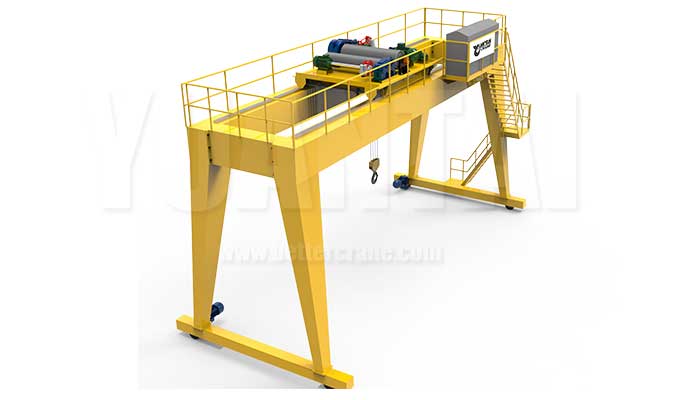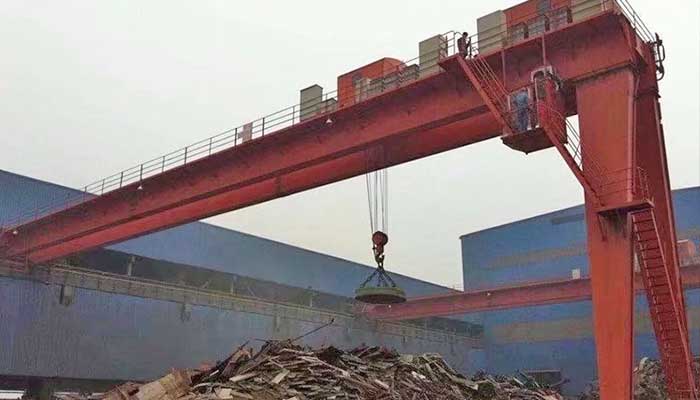Gantry Cranes Philippines for Steel Plate Handling in Shipbuilding Yards
Gantry Cranes Philipipines for Steel Plate Handling in Shipbuilding Yards
Shipbuilding is a meticulous craft that requires precision at every stage of the process. From the construction of massive hulls to the assembly of intricate components, accuracy is paramount to ensure the structural integrity and seaworthiness of the vessels being built. At the heart of this precision lies the efficient handling of materials, particularly steel plates and profiles, which form the backbone of any ship.
Gantry cranes play a pivotal role in the shipbuilding industry, serving as the workhorses that facilitate the movement of heavy and bulky materials with ease and precision. These robust machines are specifically designed to handle the rigorous demands of shipyard environments, where steel plates need to be maneuvered with accuracy to ensure seamless assembly and construction.
In this blog, we'll explore the crucial role of gantry cranes in shipbuilding yards, focusing on their unparalleled ability to handle steel plates with precision and efficiency. Let's delve into how these mighty machines contribute to the success of shipbuilding operations and the seamless construction of vessels that navigate the world's oceans.
Gantry Cranes for Steel Mill Plants
Gantry cranes are the unsung heroes of shipbuilding yards, offering unmatched versatility and power in handling heavy loads like steel plates and profiles. Unlike other cranes, gantry cranes are distinguished by their sturdy framework, which includes horizontal beams supported by legs that run along rails or tracks.
What sets gantry cranes apart is their ability to straddle objects or work areas, providing a wide range of motion and flexibility in material handling. These cranes come in various configurations to suit different needs and space constraints within shipbuilding yards.
Some common configurations include single girder gantry cranes, which feature a single horizontal beam for lifting, and double girder gantry cranes, which have two parallel beams for added stability and lifting capacity. Additionally, there are semi-gantry cranes that are supported by one end leg and run on a single rail, as well as full gantry cranes that are supported by legs on both sides and run on double rails.
Each configuration offers its own set of advantages, allowing shipbuilders to choose the most suitable option based on their specific requirements and operational constraints. Whether it's navigating tight spaces or lifting heavy loads with precision, gantry cranes are indispensable assets in shipbuilding yards, ensuring smooth and efficient material handling operations from start to finish.
Types of Gantry Cranes for Steel Plate Handling
When it comes to handling steel plates in industrial settings such as shipyards or steel fabrication plants, several types of gantry cranes and below-hook devices are commonly used. Let's explore them:
Types of Gantry Cranes for Steel Plate Handling:
These gantry cranes feature a single girder spanning the width of the crane bridge. They are suitable for lighter to moderate loads and are often used in smaller-scale operations.

Double Girder Gantry Crane
Double girder gantry cranes have two girders running parallel to each other atop the crane bridge. They offer increased lifting capacity and are suitable for heavy-duty applications such as handling large steel plates.

Semi-Gantry Crane
Semi-gantry cranes are designed with one end supported by a runway beam or building structure, while the other end travels along a track on the ground. They are ideal for situations where space constraints or uneven ground make traditional gantry crane installation challenging.

Portable Gantry Crane
Portable gantry cranes are lightweight and easily movable, making them suitable for temporary or mobile applications. They are often used in smaller workshops or construction sites for handling steel plates and other materials.
Types of Below-Hook Devices for Steel Plate Handling:
- Plate Lifting Clamps - Plate lifting clamps are specially designed to grip and lift individual steel plates securely. They come in various configurations depending on the thickness and shape of the plates being handled.
- Vacuum Lifters - Vacuum lifters use suction cups to create a vacuum seal on the surface of steel plates, allowing them to be lifted and moved without the need for mechanical clamps. They are ideal for handling smooth and flat steel plates.
- Electro-Permanent Magnets - Electro-permanent magnets utilize an electrically powered magnetic system to lift and hold steel plates. They offer quick and efficient operation and are suitable for both flat and curved plates.
- Sheet Lifting Tongs - Sheet lifting tongs are designed to grip and lift multiple steel plates simultaneously. They feature adjustable arms or jaws to accommodate different sizes of plates and are commonly used in heavy-duty applications.
- C-Hooks - C-hooks are shaped like the letter "C" and are used to cradle and lift steel plates along their edges. They are suitable for handling large and heavy plates and offer a simple and effective solution for material handling.
These are just a few examples of the types of gantry cranes and below-hook devices commonly used for steel plate handling. The choice of equipment depends on factors such as the size and weight of the plates, the layout of the facility, and specific operational requirements.
Types of Workshops/Plants: Shipbuilding Yards
Shipbuilding yards are the bustling hubs where the dreams of seafaring vessels come to life. These facilities are dedicated to the intricate process of constructing ships and boats, from the initial laying of the keel to the final outfitting and sea trials. Within the vast expanse of a shipbuilding yard, various workshops and plants play crucial roles in different stages of the shipbuilding process.
At the heart of the shipyard are the fabrication shops, where steel plates and profiles are cut, shaped, and welded to form the structural components of the vessel. These workshops are equipped with state-of-the-art machinery and skilled craftsmen who work tirelessly to ensure the precise fabrication of ship components.
Adjacent to the fabrication shops are the assembly areas, where the individual components of the ship are brought together to form the hull, superstructure, and other key sections of the vessel. Here, gantry cranes reign supreme, providing the muscle and precision needed to lift and maneuver heavy steel plates into place.
Throughout the shipyard, efficient material handling equipment is essential to keep operations running smoothly. Gantry cranes play a vital role in this regard, offering the agility and strength required to transport materials safely and efficiently across the shipyard floor. Their ability to straddle work areas and navigate tight spaces makes them indispensable assets in the complex layout of a shipbuilding yard.
In the environment of a shipyard, where time is of the essence and precision is paramount, the need for efficient material handling equipment cannot be overstated. Gantry cranes, with their versatility and power, play a pivotal role in ensuring that shipbuilding operations proceed seamlessly, from the fabrication of steel plates to the final assembly of the vessel.
Loads Handling: Steel Plates and Profiles
In the dynamic environment of shipbuilding yards, gantry cranes are tasked with the crucial role of handling heavy and bulky materials, with steel plates and profiles being among the primary loads. These essential components form the structural framework of vessels, making their precise handling a top priority in shipbuilding operations.
Steel plates, often weighing several tons and varying in thickness, are fundamental building blocks in ship construction. Gantry cranes are adept at lifting and maneuvering these massive plates with precision, ensuring they are positioned accurately for welding and assembly. Whether it's loading plates onto cutting tables in fabrication shops or transferring them to assembly areas for hull construction, gantry cranes play a vital role in every step of the process.
Similarly, steel profiles, such as beams, angles, and channels, are integral to the structural integrity of ships. Gantry cranes excel at handling these specialized profiles, lifting them with ease and placing them precisely where they are needed in the assembly process. Whether it's positioning bulkheads, stringers, or other structural components, gantry cranes ensure that steel profiles are handled with the utmost care and accuracy.
The importance of precision and accuracy in handling steel plates and profiles cannot be overstated. Any misalignment or mishandling can result in costly errors, delays, and compromised structural integrity. Gantry cranes, with their precise controls and robust construction, offer the reliability and accuracy required to safely maneuver these heavy materials, minimizing the risk of accidents and ensuring the seamless progression of shipbuilding operations.
In the fast-paced world of shipbuilding, where deadlines are tight and quality is paramount, gantry cranes play a crucial role in maintaining efficiency and productivity. By expertly handling steel plates and profiles with precision and accuracy, these mighty machines contribute to the successful construction of vessels that navigate the world's oceans with confidence and reliability.
Typical Locations in the Philippines: Shipyard Facilities
The Philippines boasts a thriving maritime industry, with several major shipyard facilities scattered across the archipelago. Among these, Cebu, Subic Bay, and Batangas stand out as key hubs for shipbuilding and repair activities.
Cebu
Cebu is home to some of the country's largest and most advanced shipyards, catering to both domestic and international markets. Shipbuilding facilities in Cebu are strategically located along the coast, providing easy access to shipping lanes and maritime infrastructure.
Gantry cranes play a pivotal role in Cebu's shipyards, facilitating the efficient handling of steel plates and other materials in the construction of various vessel types, from cargo ships to passenger ferries.
Subic Bay
Located on the west coast of Luzon, Subic Bay Freeport Zone is a major maritime hub known for its world-class shipbuilding and repair facilities. Formerly a United States naval base, Subic Bay has been transformed into a thriving industrial zone, with modern shipyards equipped with state-of-the-art infrastructure.
Gantry cranes are indispensable assets in Subic Bay's shipyards, where they are instrumental in the assembly and outfitting of vessels ranging from naval ships to offshore platforms. Their versatility and power ensure the seamless handling of steel plates and other heavy materials, contributing to the efficiency of shipbuilding operations.
Batangas
Situated on the southern coast of Luzon, Batangas is another key location for shipbuilding activities in the Philippines. The region's strategic location near major shipping routes and ports makes it an ideal location for shipyard facilities.
Gantry cranes play a crucial role in Batangas' shipyards, where they are essential for lifting and positioning steel plates during the construction of various vessel types. Their precision handling capabilities contribute to the quality and reliability of shipbuilding operations in the region.
In these bustling shipyard facilities across the Philippines, gantry cranes are indispensable tools for the efficient handling of steel plates and other materials essential to shipbuilding operations. Their robust construction, precise controls, and versatility make them essential assets in the construction of vessels that ply the world's oceans, ensuring that shipyard operations run smoothly and efficiently.
Conclusion
In conclusion, gantry cranes play a vital role in the success of shipbuilding operations in the Philippines, particularly in the precise handling of steel plates. Throughout this discussion, we've highlighted the importance of these powerful machines in shipyard facilities across key locations such as Cebu, Subic Bay, and Batangas.
Gantry cranes are not just tools; they are indispensable assets that ensure the efficiency and productivity of shipbuilding operations. With their ability to lift and maneuver heavy steel plates with precision and accuracy, gantry cranes contribute to the seamless construction of vessels that navigate the world's oceans.
Efficient material handling equipment, such as gantry cranes, is essential for the success of shipbuilding operations in the Philippines. As the maritime industry continues to thrive, the significance of gantry cranes in facilitating precision steel plate handling cannot be overstated.
In closing, we emphasize the crucial role of gantry cranes in shipbuilding yards and the importance of investing in efficient material handling equipment to ensure the success and competitiveness of the Philippine shipbuilding industry. With gantry cranes at the helm, shipyard operations can sail smoothly towards greater efficiency, productivity, and success.




